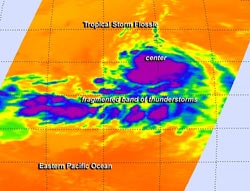NASA's Infrared Data Shows Tropical Storm Flossie's Strength

The AIRS instrument aboard NASA's Aqua satellite captured this infrared image of Tropical Storm Flossie on July 25. Strongest storms and heaviest rains are around the center and in a fragmented band of thunderstorms south of the center with cloud top temperatures near -63F/-52C (purple). <br>Image Credit: NASA JPL/Ed Olsen<br>
The Atmospheric Infrared Sounder or AIRS instrument flies aboard NASA's Aqua satellite. AIRS captured an infrared image of Tropical Storm Flossie on July 25 at 10:05 UTC (6:05 a.m. EDT). Infrared data helps determine temperature, such as the cloud top and sea surface temperatures.
AIRS data revealed that Flossie's strongest storms and heaviest rains were around its center and in a fragmented band of thunderstorms south of the center. Those areas had cloud top temperatures near -63F/-52C, indicating very high thunderstorms.
The National Hurricane Center or NHC noted that at 8 a.m. PDT (11 a.m. EDT) the center of Tropical Storm Flossie was near latitude 15.3 north and longitude 125.6 west. Flossie is moving toward the west near 16 mph (26 kph) and is expected to continue in that direction for the next couple of days. Flossie's maximum sustained winds remain near 40 mph (65 kph) and NHC expects some strengthening during the next 48 hours. The estimated minimum central pressure is 1003 millibars.
The NHC's current forecast track takes Flossie toward Hawaii as a depression by Tuesday, July 30.
Text credit: Rob Gutro
NASA's Goddard Space Flight Center
Media Contact
All latest news from the category: Earth Sciences
Earth Sciences (also referred to as Geosciences), which deals with basic issues surrounding our planet, plays a vital role in the area of energy and raw materials supply.
Earth Sciences comprises subjects such as geology, geography, geological informatics, paleontology, mineralogy, petrography, crystallography, geophysics, geodesy, glaciology, cartography, photogrammetry, meteorology and seismology, early-warning systems, earthquake research and polar research.
Newest articles

Trotting robots reveal emergence of animal gait transitions
A four-legged robot trained with machine learning by EPFL researchers has learned to avoid falls by spontaneously switching between walking, trotting, and pronking – a milestone for roboticists as well…

Innovation promises to prevent power pole-top fires
Engineers in Australia have found a new way to make power-pole insulators resistant to fire and electrical sparking, promising to prevent dangerous pole-top fires and reduce blackouts. Pole-top fires pose…

Possible alternative to antibiotics produced by bacteria
Antibacterial substance from staphylococci discovered with new mechanism of action against natural competitors. Many bacteria produce substances to gain an advantage over competitors in their highly competitive natural environment. Researchers…





















